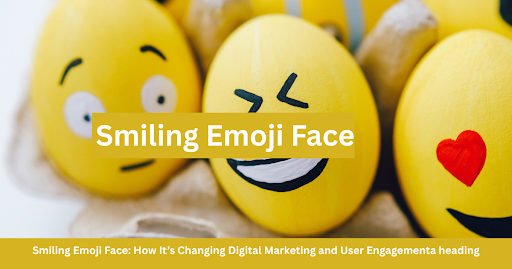A Tiny Icon, a Big Impact
Once fair a perky image in individual chats, the grinning emoji confront 😊 has presently penetrated each corner of our advanced lives — from emails and tweets to advertisement campaigns and corporate pamphlets.
It may see like a basic yellow confront with a smile emoji face, but behind that small symbol lies a capable instrument that’s unobtrusively changing how brands interface with their audiences.
In today’s fast-moving, attention-fragmented world, computerized promoting is all around relatability and enthusiastic reverberation. Shockingly, the grinning emoji confront is playing a basic part in accomplishing both.
This article jumps profound into the brain research, information, patterns, and viable techniques around this minor character — and how it’s modifying the rules of client engagement.
The Evolution of the Smiling Emoji Face
Before emojis, we had 🙂 and :-D. But these literary smileys were before long supplanted by graphical emojis with standardized plans over gadgets, making them generally recognizable.
The grinning emoji confront was one of the to begin with to be presented when emojis picked up worldwide footing in the late 1990s and early 2000s.
Over time, it advanced — from a straightforward grin 😊 to more expressive forms like 😁, 😃, and 🙂 — each with unobtrusive enthusiastic subtlety.
What remained consistent, be that as it may, was its part as a tone-softener, a warmth carrier, and a bridge in computerized communication.
Why Emojis Work: The Psychology Behind the Smile
There’s a profound mental reason why emojis, particularly grinning ones, resound with users:
They imitate facial expressions: The human brain reacts to emojis additionally to genuine faces. A grinning emoji can trigger the same enthusiastic reaction as seeing somebody grin in genuine life.
They diminish uncertainty: Content needs vocal tone. A basic message like “Let’s talk” can sound debilitating or inviting depending on setting. Include a 😊, and it feels more welcoming.
They increment relatability: Emojis humanize brands and substance. A grin can make a corporate message feel less like a deals pitch and more like a conversation.
Researchers at the College of Missouri-St. Louis found that utilizing emojis in communication increments seen warmth and believe. That’s gold for marketers attempting to construct devotion in the computerized space.
The Smiling Emoji Face in Digital Marketing
Marketers are presently grasping the grinning emoji confront in everything from subject lines to social captions, landing pages to thrust notices. But this isn’t arbitrary — it’s a consider strategy.
1. Boosting Email Open Rates
Let’s confront it — inboxes are warzones. Everyone’s competing for consideration. Counting a grinning emoji in the subject line is an simple way to make an e-mail pop visually.
Example:
Instep of: “Your week after week upgrade is here”
Attempt: “😊 Your week after week upgrade is here – it’s a great one!”
Campaign Screen found that emails with emojis in the subject line saw a higher open rate by up to 56%, especially in B2C campaigns.
2. Increasing Click-Throughs on Social Media
The grinning emoji acts as a visual snare on stages like Instagram, Facebook, and Twitter/X. It’s colorful, recognizable, and promptly registers as positive.
Posts that utilize it tend to see higher engagement, particularly when the emoji is portion of a relatable tone.
Tip: Utilize the emoji early in your caption. Emojis at the starting of a post offer assistance break the scroll design and welcome curiosity.
3. Strengthening Brand Voice
Not each brand can bear to sound like a individual. But the grinning emoji makes a difference bridge that convention hole without compromising professionalism.
A bank utilizing a grinning emoji in a reserve funds update feels more strong than robotic.
A SaaS company including it to a include upgrade message sounds less like a designer, more like a friend.
It’s not around being casual; it’s approximately being approachable.
How Brands Are Using the Smiling Emoji Face
Let’s see at how best brands have unpretentiously (and keenly) coordinates the grinning emoji confront into their advanced communication strategies.
1. Duolingo
Duolingo’s thrust notices and emails are stuffed with emojis — particularly the grinning confront. Why? Since dialect learning can feel unpleasant. A cheerful emoji makes the update feel more like support than nagging.
“You’re so near to your streak objective! 😊 Tap here to wrap up today’s lesson.”
2. Spotify
Spotify employments grinning emojis in client emails when celebrating playlist turning points or year-in-review outlines. It includes bliss to client accomplishments and fortifies enthusiastic attachment.
“You’ve made a few extraordinary music choices this year! 😊 Let’s see back.”
3. Starbucks
Starbucks regularly employments the grinning emoji in regular campaigns to include warmth and neighborliness to their limited-time offers.
“Your favorite pumpkin zest drink is back! 😊 Come say hi.”
It’s unobtrusive but makes the message feel like it’s from a barista, not a corporation.
The Science of Engagement: Data Speaks

While emoji utilize still requires setting and adjust, there’s developing information supporting its positive affect on engagement:
Increased client interaction: Social posts with grinning emojis gotten up to 33% more engagement, concurring to a 2023 Grow Social study.
Positive assumption: Posts with grinning emojis are more likely to be evaluated as candidly positive.
Higher stay time: Clients tend to spend more time on pages where the tone is inviting and welcoming — and the emoji contributes to that tone
In brief, the grinning emoji confront isn’t fair “cute” — it’s conversion-friendly.
Dos and Don’ts: Using Smiling Emoji Face the Right Way
✅ DO: Match the Emoji to the Tone
Not all messages warrant a grin. But when your expectation is to make ease, support, or appreciation, the 😊 is your go-to.
❌ DON’T: Overdo It
Too numerous emojis can feel spammy or amateurish. Sprinkle, don’t pour.
✅ DO: Test Placement
Try including the grinning emoji at the starting, center, or conclusion of a sentence — at that point A/B test to see where it works best for your audience.
❌ DON’T: Rely on It Alone
An emoji can improve your message but shouldn’t carry it. Your duplicate must still provide clarity and value.
Smiling Emoji Face in UX and Interface Design
Outside of duplicate and showcasing, grinning emojis are showing up in client interfacing as well — from stacking screens to blunder messages.
Example:
A nourishment conveyance app might appear a grinning confront another to “We’re planning your arrange 😊” — this includes persistence and inspiration to waiting.
In blunder messages:
Instep of a cold “Oops! Something went wrong,” numerous apps presently say “Looks like something didn’t go as arranged 😊 Let’s settle it.”
This apparently little expansion makes a difference mollify the blow and diminishes client frustration.
How Emojis Are Changing Client Service
Live chat and chatbot interfacing are progressively utilizing emojis, particularly grinning ones, to make bolster discussions more pleasant.
A bot saying “Hi! 😊 How can I offer assistance you today?” sets a inviting tone from the start.
Even a closing line like “Glad I might offer assistance nowadays! 😊” makes strides client fulfillment rates.
According to a Zendesk report, back intuitive that included emojis had 8% higher client fulfillment scores.
How Emojis Are Changing Customer Service
While the grinning emoji confront is broadly caught on, distinctive districts may translate emojis in somewhat diverse ways.
In Western societies, the grinning confront is generally positive.
In East Asia, individuals regularly incline toward text-based emoticons like (^_^), in spite of the fact that the grinning emoji is still broadly used.
In Center Eastern markets, brands must guarantee emoji utilization adjusts with neighborhood standards of formality.
Tip: When promoting over borders, test emoji utilize with localized audiences.
Smiling Emoji and Voice Assistants
Interestingly, emojis are indeed affecting how voice colleagues and AI chatbots sound.
When client interfacing mirror emoji tone (cheerful, compassionate), clients report higher satisfaction.
Though talked AI can’t appear emojis, the enthusiastic tone can coordinate that passed on by 😊 — inviting, calm, non-threatening.
In future interfacing, visual emoji input may combine with vocal emphases to make sincerely brilliantly bots.
The Future of Emoji in Marketing
- The emoji dialect isn’t inactive. It’s evolving.
- Animated emojis (Animoji) are on the rise.
- Custom brand emojis (like Twitter’s branded hashtags) are increasing.
- AI-generated emojis may gotten to be the another huge thing in personalization.
Still, through all this development, the humble grinning emoji confront remains the bedrock of emoji communication — since invitingness never goes out of style.
Final Thoughts: Why It Works, and What It Says About Us
The grinning emoji confront works since it taps into something profoundly human: the require to feel caught on and sincerely acknowledged.
In a computerized world where tone can be misinterpret and screens overwhelm our intelligent, a little grin — indeed a virtual one — goes a long way. It’s not fair beautification. It’s communication.
Marketers who get it the inconspicuous control of this symbol aren’t fair chasing patterns. They’re recognizing that, at its center, engagement isn’t approximately innovation. It’s almost emotion.
FAQs:
How does the grinning emoji confront affect advanced marketing?
It upgrades enthusiastic association, increments engagement, and boosts message clarity.
Can utilizing emojis in showcasing make strides client reaction rates?
Yes, emojis like the grinning confront frequently lead to higher open, click-through, and fulfillment rates.
Is the grinning emoji confront fitting for all brands?
Most brands can utilize it successfully, as long as it adjusts with their tone and audience.
What are best hones for utilizing the grinning emoji in campaigns?
Utilize it sparingly, in setting, and continuously test arrangement and group of onlookers response.


